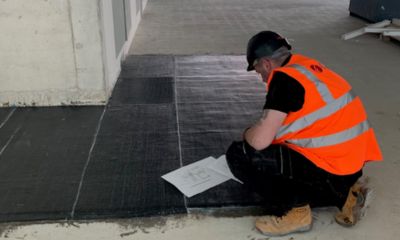Carbon fibre strengthening can shave time and money off your upcoming project. Ask about carbon fibre today
If you’re looking for a structural reinforcement method for an upcoming project, ask your contractor about carbon fibre strengthening. Carbon fibre can save you time and money, and in this blog, we’ll explain how this is achieved. Here are the 4 main reasons why carbon fibre strengthening adds value to your projects, saving you time and money. We hope you find this blog useful – and if you prefer to watch a video version – click play below! If you’ve any questions, please feel free to get in touch with our expert team today. We’re always happy to help.
Carbon fibre strengthening of concrete: Our preferred reinforcement & rehabilitation method
#1: Carbon fibre is suitable for almost any building or structure
Where is carbon fibre used?
Due to carbon fibre’s stiffness and overall integrity, CFRPs can be used to strengthen, reinforce, and rehabilitate almost any building or structure. They can even be used as part of a concrete repair job Carbon fibre comes in lots of different forms, including:
- Carbon fibre sheets
- Carbon fibre wraps, or carbon fibre wrapping
- Carbon fibre plates
- Carbon fibre plate bonding.
Carbon fibre comes in different types, too. These depend on two variables – `Modulus` and `Fibre`. Modulus ranges from low to ultra-high (100GPa – 500GPa), with low meaning the lowest strength available and ultra-high meaning the strongest in tensile strength. Types of fibre materials include[1]:
- PAN-based carbon fibre
- Pitch-based carbon fibre
- Mesophase pitch-based carbon fibre
- Isotropic pitch-based carbon fibre
- Rayon-based carbon fibre
All types of carbon fibre are highly resistant to chemicals.
This assortment of forms/types, along with its flexibility and thinness, makes carbon fibre an easy material to manipulate into any shape and style you want. At CCUK, our expert team offers a free carbon fibre design service. You can access this when requesting your free feasibility survey and cost analysis. Book yours via our online form or call us today.
Not ready to book? Read more about which buildings and structures are compatible with carbon fibre strengthening on our designated page instead
#2: Carbon fibre is environmentally friendly
How is carbon fibre made?
Carbon fibre is an environmentally-friendly composite material used for structural strengthening projects.
The creation of carbon fibre includes 5 key phases:
- Spinning
- Stabilisation
- Carbonising
- Surface treatment
- Sizing
Carbon fibre is made up of carbon atoms, woven fibres and epoxy resin – a matrix that’s not only extremely versatile but kind to the earth and far better for the environment than other man-made materials that do a similar job, like steel and fibreglass.
What’s more, because carbon fibre is constantly increasing in demand, it’s readily available and competitively priced. Carbon fibre strengthening projects are, generally, shorter in length from project start to completion, easily saving you time and money.
To learn more about the fascinating creation process, skip to this blog on textileproperty.com.
#3: Carbon fibre is stronger than steel and fibreglass
What makes carbon fibre so strong?
Carbon fibre strength rivals the other well-trusted industrial materials we use, like steel and fibreglass. CCUK Owner Steve Musa says: “Carbon fibre is, in fact, 3-4 times stronger than steel”. You may wonder, `How is carbon fibre stronger than steel when it’s thinner than a strand of hair?`. That’s a very good question! Well, the super material gets its strength only when the hair-like strands are woven together, much like sheep’s wool used for knitting.
Is carbon fibre stronger than steel?
When we talk about carbon fibre strength, we are referring to three kinds: tensile strength, compressive strength, and yield strength.
Carbon fibre tensile strength
This is the resistance of a material when it’s put under tension. Typically, carbon fibre’s tensile strength is 600 compared to steel’s tensile strength of 420 and aluminium’s 276.
Carbon fibre compressive strength
This is the amount of load-bearing a material can tolerate. For an example, ask our expert team here.
Carbon fibre yield strength
This is the level of `stress-strain` a material can deal with. For an example, ask our expert team here.
Furthermore, the durability of carbon fibre is plentiful, and the material can be easily repaired.
#4: Carbon fibre is extremely light-weight and thinner than human hair
Whilst carbon fibre is not as light as a feather, it is thinner than a strand of human hair. This means carbon fibre strengthening requires fewer contractors on a job and takes less time to finish because the material is so easy to carry around. There’s also no need to hire machinery or equipment because of its lightweight property, so there’s an extra cost saving there. CCUK Owner Jamie Dempster adds: “Carbon fibre is 7-8 times lighter than steel”.
Book your free feasibility survey
Learn more about carbon fibre strengthening via our expert blogs
Our expert blog section is jam-packed with blogs about carbon fibre strengthening, along with other popular topics surrounding concrete reinforcement in the commercial sphere.
- Our no1 choice: Carbon fibre for structural strengthening
- The do’s and don’ts of using carbon fibre strengthening materials
- Is carbon fibre a sustainable material for strengthening buildings and structures
- The industrial uses of carbon fibre reinforced polymer applications
References:
[1] textileproperty.com





